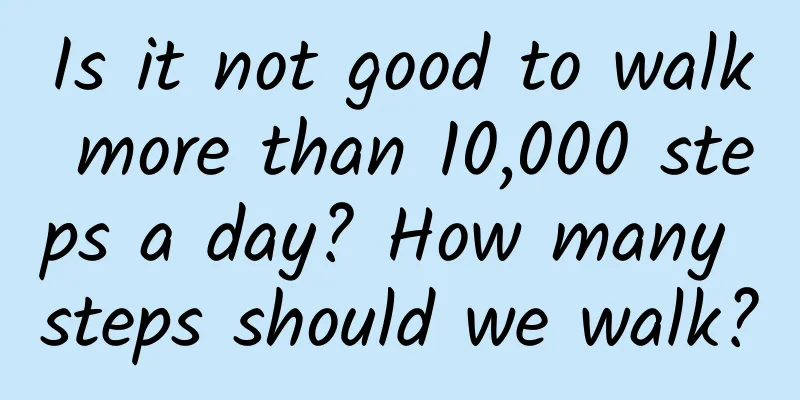Is it not good to walk more than 10,000 steps a day? How many steps should we walk?

|
Many people shake their phones when they sit down, hoping that their daily step count will be higher so that they can improve their step count ranking in their circle of friends. Some people can even give 20,000 to 30,000 steps a day. Do you really need to work so hard to walk? A study recently published in The Lancet Public Health found that in order to stay healthy, you don’t need to walk tens of thousands of steps a day. 8,000 to 10,000 steps a day for middle-aged people and 6,000 to 8,000 steps a day for the elderly are enough. Moreover, the average walking speed is not that important (Paluch AE et al, 2022). Hearing this, many people will definitely be a little confused: I thought only brisk walking has health benefits, but it turns out that slow walking is also okay? To correctly understand this study, there are several key points that must be explained: Point 1: The indicator of this study is not weight loss, but the risk of all-cause mortality. Simply put: adding more steps above 10,000 a day has no additional effect on health and longevity. The person who walks the most is not necessarily the one who lives the longest. The researchers found that compared with the lowest group of people who walked only about 3,500 steps a day, the risk of death was reduced by 40%, 45%, and 53% for those who walked 5,800 steps, 7,800 steps, and more than 10,000 steps, respectively. After more than 10,000 steps, the further reduction in the risk of death was not significant. Further analysis by age group found that for the elderly over 60, the risk of death did not decrease further after more than 8,000 steps a day. Point 2: This is a study of middle-aged and elderly people with an average age of 65. Young people do not have to constrain themselves by the research results of the elderly. Healthy young people should walk briskly. They should be able to run and jump, have plenty of energy, and be able to recover after a night's sleep. This is the state of youth. If you can only walk slowly in your twenties or thirties, and feel tired after walking 10,000 steps, then you are sick or old. The metabolic rate of the elderly decreases, joints wear out, and fatigue recovery ability also decreases. As long as exercise can achieve the goal of maintaining musculoskeletal and cardiopulmonary function and improving blood circulation, excessive fatigue is actually detrimental to their health. Point 3: This is a long-term observation study with 47,000 participants for an average of 7.1 years, not a short-term weight loss study. Lifestyle habits over many years are not the same as short-term weight loss measures. If you walk to lose weight or eliminate fatty liver, then walking slowly is definitely not as good as walking fast. A total of 10,000 steps is enough, but the quality of these 10,000 steps must be guaranteed, and a portion of them must reach the fat-reducing heart rate to achieve better results. Most people reach their peak weight between the ages of 50 and 65. As they age, their weight will slowly decrease. Especially for the elderly, being too thin is not conducive to health and longevity. Therefore, for the elderly, losing weight is not the main goal of exercise. Point 4: The 10,000 steps a day include not only exercise but also the amount of activity in daily life. These studies obtained exercise data by giving subjects smart bracelets that monitor their exercise status. Daily walking is also counted. However, for example, walking five or six steps from the sofa to the table next to you to get a cup of coffee is probably not counted. A regular pedometer will only count your steps if you walk more than ten steps in a row. Of course, for people who sit for a long time, even if they can get up and walk eight or ten steps to go to the bathroom, it is better for blood circulation than sitting all the time. Point 5: The data summarized in this study were all conducted in developed Western countries, and the majority of the subjects were middle-aged and elderly white women. Since this is a study in developed countries, and the subjects are healthy middle-aged and elderly people who have been screened and have good living conditions, and do not include data on malnourished and sick people, it is still uncertain whether it can be fully applied to developing countries, whether it has the same effect in men, and whether it has the same effect on various patients. What I'm interested in is this result: people with the fastest peak walking speed in 30 minutes or 60 minutes have a 33% lower risk of death than those with the slowest walking speed. This means that people who can walk fast are healthier and live longer than those who can't walk fast. The average walking speed throughout the day doesn't have such a big impact. The implication of this result is this: you need to maintain your body's ability, but you don't have to consume it at any time. You can run fast, you can walk fast, but only sometimes, you don't need to run so fast all the time. If you have to run as fast as you can for a long time, it may be a loss to your body, and it may not be conducive to health and longevity. Just like lions and cheetahs, they can run very fast when they are attacking their prey, but they are usually lazy. If they have to run so fast for a long time every day, wouldn’t it make the body more tired and increase the demand for food significantly? The same is true for cars. You can accelerate to high speed when needed, but you don't have to drive at full speed all the time. Doing so will not only waste fuel, but also cause the car to wear out and break down faster. Studies have found that excessive high-intensity interval training (HIIT) can damage mitochondrial function and reduce glucose tolerance in healthy people. Even for athletes, excessive high-intensity exercise can cause more time in a high blood sugar state during the day (Flockhart M et al, 2021). Therefore, if you are not overweight or obese, and you are not a model or athlete, there is no need to go to the gym five or six days a week. 2-3 times is enough to maintain muscle. If you are not a runner and do not plan to participate in a marathon, there is no need to run 10 kilometers every day. Running more than ten kilometers a week is enough to build a liver with moderate fat content and maintain good immunity. If you don't plan to participate in a running competition, you don't have to run so fast all the time. You can run two or three kilometers faster every week to maintain your speed and cardiopulmonary function, and you can run comfortably at a moderate to slow pace for the rest of the time. Of course, these studies have not seriously considered individual differences and physical foundations. People are very different. Some people are naturally strong and can maintain a lot of exercise for a long time. There is no need to deliberately reduce the amount of exercise because of these studies. However, some people have weak foundations, limited physical strength, work fatigue, aging, or even existing illnesses. In this case, they might as well adopt the "highest health benefit" exercise method, which maintains the highest walking speed without pursuing a long walk. Nowadays, we not only have pedometers and mobile phones, but many people also wear sports bracelets and smart watches. Smart running companions will remind you how many meters you are behind it. Every kilometer, it will tell you your pace. Sports apps will also tell you what your ranking is in the circle, how far you are from the next medal, and so on. Under this kind of pressure, people tend to unconsciously increase their exercise intensity, comparing themselves with others and always wanting to set new records. However, they often forget the original meaning of exercise - to promote health and improve the quality of life, not to set records, win medals, or show off certain data in the circle of friends. Don't forget your original intention, take health as your goal, exercise in a way that is comfortable for your body, and don't compare your speed and steps with others. You can leave more energy for work and life, and also have fewer unnecessary worries and troubles. References: 1 Paluch AE, Bajpai S, Bassett DR, et al. Daily steps and all-cause mortality: a meta-analysis of 15 international cohorts. Lancet Public Health. 2022;7(3):e219-e228. 2 Flockhart M, Nilsson LC, Tais S, et al. Excessive exercise training causes mitochondrial functional impairment and decreases glucose tolerance in healthy volunteers. Cell Metabolism, 2021, 33:1-14 Reprint/ Cooperation please contact Weibo/ Official Account: Fan Zhihong_Original Nutrition Information |
<<: The "magic weapon" for weight loss, the sweat-inducing suit, will make you pay the "IQ tax"?
>>: I want to listen to two songs at the same time, brain: No, I can't do that
Recommend
Foreign media commented on BlackBerry's launch of Android phones: It's a self-humiliation
[[136684]] Foreign media wrote an article comment...
Things about naming asteroids: Stars that cost money are not good stars
Produced by: Science Popularization China Produce...
How to decertify the Tik Tok corporate account? Can Tik Tok cancel its corporate certification?
How to cancel Douyin’s corporate certification ? ...
How much do you know about the pros and cons of ultrasound, X-ray, CT, MRI and PET-CT examinations?
In recent years, the rapid development of medical...
Is it expensive to customize the Wuhu food ordering app? Wuhu ordering app customization cost and process
More and more businesses are paying attention to ...
ZenFone Zoom: Will ASUS, a tech-geek brand, be the next HTC?
When it comes to ASUS mobile phones, for some ent...
How many volts of static electricity can cause sparks to fly from your fingers? | Science Gallery
Is this scene familiar to everyone? This is one o...
Apple: If you accidentally drop your iPhone XR, the cost of repair could be as high as 73% of the price of a new phone
With Apple opening pre-orders for the iPhone XR o...
Why are 16-megapixel mobile phone photos not as good as iPhone?
The image quality of digital cameras is a commonp...
Things that are more harmful to your liver than staying up late may be what you do every day
1. Healthy eating habits : eat regularly, avoid o...
What is Xu Jiayin’s real intention when he emphasized that “seeing is believing” after inspecting Jia Yueting’s FF?
Evergrande Chairman Xu Jiayin spent nearly HK$7 b...
Tarot Primary Teaching Baidu Cloud Download
Introduction to Tarot Primary Teaching Resources:...
What to do if you lose your Apple AirPods? App to find your headphones is now available
Since Apple AirPods wireless Bluetooth earphones ...
8 words, a simple and rough analysis of the problem that all information flow advertising optimizers have been confused about
Recently, I have received 20 to 30 private messag...
Traffic is as valuable as gold. How to take the first step in promoting mutual financial products?
The customer acquisition price of Internet financ...









